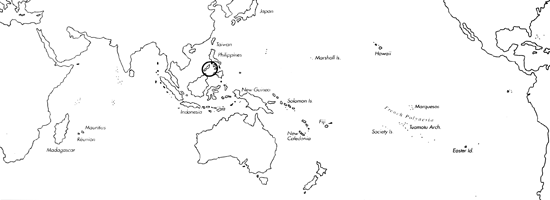Range: Philippines (Balabac, Palawan and Calamian Group, Cuyo Is.).
Description: Medium-sized to large, moderately solid to solid. Last whorl ventricosely conical to conoid-cylindrical, also sometimes conical in typical ("smooth") form (Pl. 65, Figs. 18-20); outline convex to nearly straight, often more convex in strongly sculptured shells (form rugosus) (Pl. 65, Figs. 21, 22) than in typical shells; left side slightly concave at basal third in typical form, to strongly concave in form rugosus. Aperture somewhat wider at base than near shoulder. Shoulder angulate, smooth in typical form, weakly tuberculate in form rugosus except for large adults. Spire of moderate height; outline concave to nearly straight, usually less concave in typical form. Larval shell of about 2 whorls, maximum diameter 1-1.2 mm. In typical form, first 5-7 postnuclear whorls rather weakly tuberculate; in form rugosus, first 8-9.5 postnuclear whorls tuberculate. Teleoconch sutural ramps concave; in form rugosus, ramps with 0-1 increasing to 6-11 spiral grooves; in typical form, late ramps with 3-5 weak to obsolete spiral grooves (apex usually eroded). Last whorl with weak spiral ribs on basal third in typical form, with closely spaced and finely granulose ribs from base to shoulder in form rugosus.
| Shell Morphometry | ||
|---|---|---|
| L | 48-100 mm | |
| RW | 0.15-0.40 g/mm | |
| (L 48-78 mm) | ||
| RD | 0.50-0.56 | |
| PMD | - | |
| (-typical form 0.78 - 0.87;-form rugosus 0.75 - 0.82) | ||
| RSH | - | |
| (-typical form 0.16 - 0.22;-form rugosus 0.12 - 0.21) | ||
Ground colour white. In typical form, last whorl with fine reticulated lines edging very small to medium-sized tents. On each side of centre, yellowish brown blotches forming a spiral band interrupted by larger tents; brown blotches interspersed with variable dark brown axial lines. Form rugosus with a similar pattern; reticulation light to dark brown, sometimes partially reduced. Larval whorls and a few adjacent postnuclear sutural ramps immaculate white. Following ramps matching last whorl in colour pattern. Aperture white, rarely suffused with cream.
Periostracum yellowish grey, thin, translucent, smooth.
Habitat and Habits: In 2-20 m; on coral reef, on sand substrate among rocks and coral blocks (see Old & D'Attilio, 1963).
Discussion: The typical form of C. telatus (Pl. 65, Figs. 18-20) resembles C. victoriae and typical C. textile, while form rugosus (Pl. 65, Figs. 21,22) is similar to C. aureus. C. victoriae can be distinguished by its broader last whorl (RD 0.55-0.67); C. v. victoriae is more convex in outline and C. v. nodulosus has smaller yellowish brown markings on the last whorl. For comparison with C. textile and C. aureus, see the Discussions of those species. The holotype of C. telatus is of the rather smooth variety (typical form) that seems restricted to Cuyo Is. The strongly sculptured variety (form rugosus) has a wider geographical range (Balabac northward to Calamian Group); its occurrence in Guimares Id. and in the Celebes Sea has to be verified. Although some reliable reports suggest an allopatric occurrence of both variants, we cannot unequivocally exclude co-occurrence as affirmed in other reports. Therefore, we provisionally favour the status of forms rather than that of subspecies.

C. telatus range map
This section contains verbatim reproductions of the accounts of 316 species of Conus from the Indo-Pacific region, from Manual of the Living Conidae, by Röckel, Korn and Kohn (1995). They are reproduced with the kind permission of the present publisher, Conchbooks.
All plates and figures referred to in the text are also in Röckel, Korn & Kohn, 1995. Manual of the Living Conidae Vol. 1: Indo-Pacific Region.
The range maps have been modified so that each species account has it own map, rather than one map that showed the ranges of several species in the original work. This was necessary because each species account is on a separate page on the website and not confined to the order of accounts in the book.